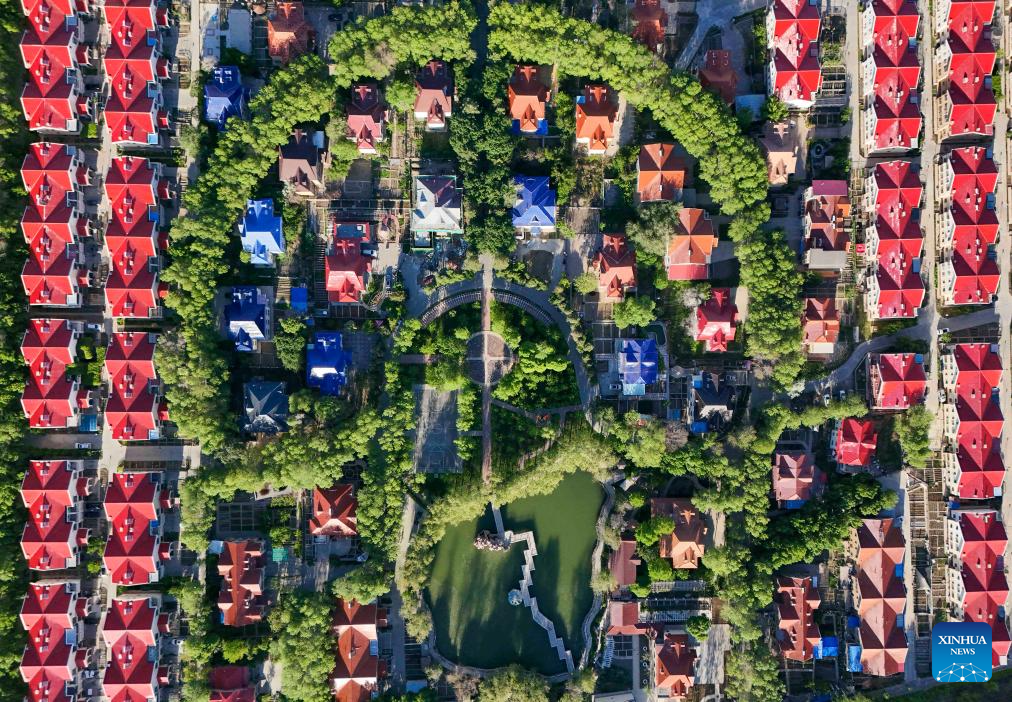
An aerial drone photo taken on May 9, 2024 shows a city view of Wujiaqu, northwest China's Xinjiang Uygur Autonomous Region. In recent years, Wujiaqu, a national garden city in northwest China's Xinjiang Uygur Autonomous Region, has made great efforts in promoting greening projects and optimizing the living ecological environment. By the end of 2023, Wujiaqu has owned over 15,700 mu (about 1,046.7 hectares) of urban green space, with a green coverage rate of more than 45 percent. (Xinhua/Hu Huhu)

An aerial drone photo taken on May 9, 2024 shows a park and its surrounding area in Wujiaqu, northwest China's Xinjiang Uygur Autonomous Region. In recent years, Wujiaqu, a national garden city in northwest China's Xinjiang Uygur Autonomous Region, has made great efforts in promoting greening projects and optimizing the living ecological environment. By the end of 2023, Wujiaqu has owned over 15,700 mu (about 1,046.7 hectares) of urban green space, with a green coverage rate of more than 45 percent. (Xinhua/Hu Huhu)

An aerial drone photo taken on May 9, 2024 shows a city view of Wujiaqu, northwest China's Xinjiang Uygur Autonomous Region. In recent years, Wujiaqu, a national garden city in northwest China's Xinjiang Uygur Autonomous Region, has made great efforts in promoting greening projects and optimizing the living ecological environment. By the end of 2023, Wujiaqu has owned over 15,700 mu (about 1,046.7 hectares) of urban green space, with a green coverage rate of more than 45 percent. (Xinhua/Hu Huhu)

This photo taken on May 9, 2024 shows the Qinggeda lake wetland in Wujiaqu, northwest China's Xinjiang Uygur Autonomous Region. In recent years, Wujiaqu, a national garden city in northwest China's Xinjiang Uygur Autonomous Region, has made great efforts in promoting greening projects and optimizing the living ecological environment. By the end of 2023, Wujiaqu has owned over 15,700 mu (about 1,046.7 hectares) of urban green space, with a green coverage rate of more than 45 percent. (Xinhua/Hu Huhu)

An aerial drone photo taken on May 9, 2024 shows a city view of Wujiaqu, northwest China's Xinjiang Uygur Autonomous Region. In recent years, Wujiaqu, a national garden city in northwest China's Xinjiang Uygur Autonomous Region, has made great efforts in promoting greening projects and optimizing the living ecological environment. By the end of 2023, Wujiaqu has owned over 15,700 mu (about 1,046.7 hectares) of urban green space, with a green coverage rate of more than 45 percent. (Xinhua/Hu Huhu)

An aerial panoramic drone photo taken on May 9, 2024 shows a city view of Wujiaqu, northwest China's Xinjiang Uygur Autonomous Region. In recent years, Wujiaqu, a national garden city in northwest China's Xinjiang Uygur Autonomous Region, has made great efforts in promoting greening projects and optimizing the living ecological environment. By the end of 2023, Wujiaqu has owned over 15,700 mu (about 1,046.7 hectares) of urban green space, with a green coverage rate of more than 45 percent. (Xinhua/Hu Huhu)

An aerial drone photo taken on May 9, 2024 shows a city view of Wujiaqu, northwest China's Xinjiang Uygur Autonomous Region. In recent years, Wujiaqu, a national garden city in northwest China's Xinjiang Uygur Autonomous Region, has made great efforts in promoting greening projects and optimizing the living ecological environment. By the end of 2023, Wujiaqu has owned over 15,700 mu (about 1,046.7 hectares) of urban green space, with a green coverage rate of more than 45 percent. (Xinhua/Hu Huhu)

An aerial drone photo taken on May 9, 2024 shows a residential area in Wujiaqu, northwest China's Xinjiang Uygur Autonomous Region. In recent years, Wujiaqu, a national garden city in northwest China's Xinjiang Uygur Autonomous Region, has made great efforts in promoting greening projects and optimizing the living ecological environment. By the end of 2023, Wujiaqu has owned over 15,700 mu (about 1,046.7 hectares) of urban green space, with a green coverage rate of more than 45 percent. (Xinhua/Hu Huhu)



